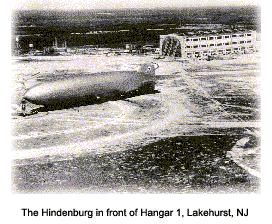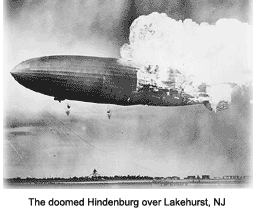During the 1930s, a relatively primitive period in world aviation, airplanes could fly only short distances and required constant refueling. Those realities stimulated the Zeppelin Company's intuitive idea of a rigid airship.
 The Hindenburg* (LZ-129) was a historic marvel of avionic engineering, built for German passengers - to date, she was the largest aircraft ever to fly. The flights of the Hindenburg, as well as Graf Zeppelin, pioneered the world's first transatlantic air service.
With hundreds of passengers and thousands of travel miles to Europe, and North and South America, the Hindenburg's fate would be tragically sealed by disaster in the sky.
The Hindenburg* (LZ-129) was a historic marvel of avionic engineering, built for German passengers - to date, she was the largest aircraft ever to fly. The flights of the Hindenburg, as well as Graf Zeppelin, pioneered the world's first transatlantic air service.
With hundreds of passengers and thousands of travel miles to Europe, and North and South America, the Hindenburg's fate would be tragically sealed by disaster in the sky.
The Zeppelin Company The German company, Luftschiffbau Zeppelin, owned by Count Ferdinand Graf von Zeppelin, was the world's most successful builder of rigid, lighter-than-air airships. Zeppelin flew the world's first non-tethered rigid airship, the LZ-1, on July 2, 1900, near Lake Constance in Germany, carrying five passengers. When the various restrictions imposed by the Treaty of Versailles on Germany were lifted, Germany was again allowed to construct airships. It built three monstrous rigid craft: the LZ-127 Graf Zeppelin, LZ-l30 Graf Zeppelin II, and of course, the LZ-l29 Hindenburg. At the height of the company's success, Zeppelin would become responsible for a tragic event that would take place near the Naval Air Station at Lakehurst, New Jersey, in 1937.
Construction of the Hindenburg
Construction began on the Hindenburg in Friedrichchafen, Germany, in 1931, and was completed in 1936. Her framework was fabricated of a light and sturdy alloy known as duralumin. Sixteen gas cells where positioned throughout the length of the gigantic ship. A fireproof gelatin solution coated each gas cell against potentially permeating hydrogen gas.
Unlike other rigid airships that Zeppelin created, the Hindenburg would carry all passengers inside her hull control car, instead of from a protruding gondola section. The control car was secured to the underside of the Hindenburg's body, which broke up the streamline effect of the remainder of the airship, and comprised three main compartments: control room/bridge, navigation room and observation area. German engineers also constructed a radio room above the control car. For safety purposes, an alternate control area was positioned in the interior of the lower vertical fin.
With a length of 803.8 feet, a diameter of 135.1 feet (7,063,000 cubic feet of hydrogen gas volume), and weighing approximately 242 tons, the Hindenburg required massive engine power to ply the sky. Four 16-cylinder Diesel engines were positioned in a staggered arrangement, two per side. Each Mercedes Benz engine was capable of 1,300 horse power at take-off; subsiding to about 850 horse power for cruising speeds.
Luxury aboard the Hindenburg
The ship was equipped with splendid accommodations and service. A comfortable and roomy lounge was available for passengers to enjoy — graced by a large wall mural that traced the path of famous explorers. The lounge also boasted a Bluthner baby grand piano, built of custom aluminum and covered with pigskin.
Huge windows in the promenade provided passengers with awesome views below. The dining room, located across the hall, was capable of accommodating all 50 guests at once. A nearby reading and writing room was a quiet place for travelers to relax and write letters on custom Hindenburg stationery.
Passenger cabins were small, only 78 x 66 inches; however, most of the passengers' time was utilized elsewhere in the airship. Officers had their own mess hall, allowing for unbelievable views of the earth passing below. Unfortunately for the rest of the crew, quarters, located at the rear of the ship, were tiny and cramped.
Ironically, the enormous airship had a smoking room — an oddity on an airborn explosion waiting to happen. The room was lined with asbestos, and equipped with an anti-chamber airlock that prevented any flames from reaching the remainder of the ship. Guests were required to turn in all lighters and matches to a holding facility before boarding the ship. In fact, the smoking room had only one community electric lighter (anchored by a cord) for the entire ship.
Political insecurities
The Hindenburg was initially meant to be filled with helium. The problem with that plan began to surface immediately. In order to keep the Zeppelin Company viable during the Depression, huge sums of money had been accepted by the now-powerful Nazi Party. A swastika emblem was affixed to the Hindenburg and Graf Zeppelin, and numerous propaganda flights over Germany had already been completed.
The United States possessed the only natural deposits of helium in the world. That factor caused U.S. government officials to become wary of Adolph Hitler and his growing Third Reich because of prior rigid German aircraft used in bombing raids during World War I.
Following a meeting with President Theodore Roosevelt and the Zeppelin Company, the U.S. Congress passed The Helium Control Act, which denied the Zeppelin Company U.S. helium for their new ship. Instead, the Hindenburg's cells were inflated with the explosive gas, hydrogen.
 Lakehurst
Naval Air Station Lakehurst was North America's first international airport. Since no privately owned airship terminals existed in the United States, the temporary use of Lakehurst was allowed by the U.S. Navy. However, there were restrictions. The United States wouldn't assume any liability or expense whatsoever. Basically, German operators would be granted the use of the facilities at their own risk. A contract between the navy and German companies was eventually signed on October 11th, 1935.
Fire in the sky
On May 3, 1937, the Hindenburg set sail from the Zeppelin's new terminal in Frankfurt, Germany; her target destination was Lakehurst Naval Air Station.
Aboard the ship were 36 passengers and a crew of 61. Delayed by unrelenting head winds, the Hindenburg did not reach the Lakehurst area until late afternoon on the sixth of May at Naval Air Station Lakehurst — a day behind the schedule of previously successful flights. At 7 p.m. Eastern Standard Time, a recommended immediate landing was released — by 7:21 p.m., the first mooring line was dropped.
Lakehurst
Naval Air Station Lakehurst was North America's first international airport. Since no privately owned airship terminals existed in the United States, the temporary use of Lakehurst was allowed by the U.S. Navy. However, there were restrictions. The United States wouldn't assume any liability or expense whatsoever. Basically, German operators would be granted the use of the facilities at their own risk. A contract between the navy and German companies was eventually signed on October 11th, 1935.
Fire in the sky
On May 3, 1937, the Hindenburg set sail from the Zeppelin's new terminal in Frankfurt, Germany; her target destination was Lakehurst Naval Air Station.
Aboard the ship were 36 passengers and a crew of 61. Delayed by unrelenting head winds, the Hindenburg did not reach the Lakehurst area until late afternoon on the sixth of May at Naval Air Station Lakehurst — a day behind the schedule of previously successful flights. At 7 p.m. Eastern Standard Time, a recommended immediate landing was released — by 7:21 p.m., the first mooring line was dropped.
 An eerie, hazy glow illuminated the massive airship's swastika emblem. As an expectant crowd of people and the media calmly looked up 200 feet in wonder, Airship Hindenburg suddenly transfixed them with fire and horror. The hydrogen fire originated at or near the stern of the ship, while carnage and mayhem scattered below her. Bodies could be seen falling to the sandy field from her burning canvas body.
Thirty-six lost their lives: 22 crewmen, 13 passengers and one civilian member of the ground crew. Germany's prize commercial jewel was lost in tragedy, never to be recovered.
Still a mystery
The exact cause of the disaster is still unknown. In 1937, many thought the ship had been hit by lightning. Some even believed that an electrical short ignited one of the stern gas cells. Many others simply accepted the obvious — highly flammable hydrogen.
Shortly after the disaster, some Germans even cried sabotage, suspecting intentional wrongdoing to besmirch the Nazi regime's reputation. NASA research suggested that the highly combustible varnish treatment on the outside fabric most likely caused the tragedy. That theory has recently been proclaimed unlikely by numerous researchers, because the Hindenburg's fabric varnish had a much lower flash point than that of the explosive hydrogen inside.
An eerie, hazy glow illuminated the massive airship's swastika emblem. As an expectant crowd of people and the media calmly looked up 200 feet in wonder, Airship Hindenburg suddenly transfixed them with fire and horror. The hydrogen fire originated at or near the stern of the ship, while carnage and mayhem scattered below her. Bodies could be seen falling to the sandy field from her burning canvas body.
Thirty-six lost their lives: 22 crewmen, 13 passengers and one civilian member of the ground crew. Germany's prize commercial jewel was lost in tragedy, never to be recovered.
Still a mystery
The exact cause of the disaster is still unknown. In 1937, many thought the ship had been hit by lightning. Some even believed that an electrical short ignited one of the stern gas cells. Many others simply accepted the obvious — highly flammable hydrogen.
Shortly after the disaster, some Germans even cried sabotage, suspecting intentional wrongdoing to besmirch the Nazi regime's reputation. NASA research suggested that the highly combustible varnish treatment on the outside fabric most likely caused the tragedy. That theory has recently been proclaimed unlikely by numerous researchers, because the Hindenburg's fabric varnish had a much lower flash point than that of the explosive hydrogen inside.